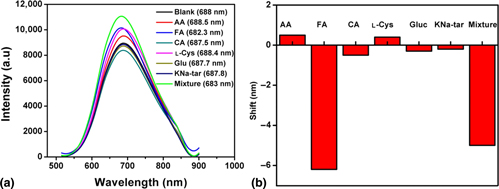Crossref Citations
This article has been cited by the following publications. This list is generated based on data provided by
Crossref.
Parani, Sundararajan
and
Oluwafemi, Oluwatobi Samuel
2020.
Selective and sensitive fluorescent nanoprobe based on AgInS2-ZnS quantum dots for the rapid detection of Cr (III) ions in the midst of interfering ions.
Nanotechnology,
Vol. 31,
Issue. 39,
p.
395501.
Fereja, Shemsu Ligani
Li, Ping
Guo, Jinhan
Fang, Zhongying
Zhang, Ziwei
Zhuang, Zhihua
Zhang, Xiaohui
Liu, Kaifan
and
Chen, Wei
2021.
Silver-enhanced fluorescence of bimetallic Au/Ag nanoclusters as ultrasensitive sensing probe for the detection of folic acid.
Talanta,
Vol. 233,
Issue. ,
p.
122469.
Xue, Tong
Shi, Yiyi
Guo, Jie
Guo, Meixian
and
Yan, Ya
2021.
Preparation of AgInS2 quantum dots and their application for Pb2+ detection based on fluorescence quenching effect.
Vacuum,
Vol. 193,
Issue. ,
p.
110514.
Rajendran, Jose Varghese
Parani, Sundararajan
Pillay R Remya, Vasudevan
Lebepe, Thabang C.
Maluleke, Rodney
Thomas, Sabu
and
Oluwafemi, Oluwatobi Samuel
2022.
Selective and sensitive detection of Cu2+ ions in the midst of other metal ions using glutathione capped CuInS2/ZnS quantum dots.
Physica E: Low-dimensional Systems and Nanostructures,
Vol. 136,
Issue. ,
p.
115026.
Zhan, Xiao‐Ye
Wang, Bin
and
Yu, Li‐Ping
2022.
Glycidol‐modified polyethylenimine‐capped carbon dots with ultrastable fluorescence for sensitive and selective detection of folic acid in food samples.
Journal of the Chinese Chemical Society,
Vol. 69,
Issue. 3,
p.
486.
Mgedle, Nande
Aladesuyi, Olanrewaju A.
Lebepe, Thabang Calvin
Ncapayi, Vuyelwa
and
Oluwafemi, Oluwatobi Samuel
2023.
Facile aqueous synthesis of ZnCuInS/ZnS–ZnS QDs with enhanced photoluminescence lifetime for selective detection of Cu(ii) ions.
Green Processing and Synthesis,
Vol. 12,
Issue. 1,
Wang, Ningyi
Liu, Bingwei
Wu, Xu
and
Peng, Yan
2024.
Novel THz Metasurface Biosensor for High-Sensitivity Detection of Vitamin C and Vitamin B9.
Photonics,
Vol. 11,
Issue. 9,
p.
820.
Sevgül Bakay, Melahat
Elibol, Erdem
and
Çadırcı, Musa
2024.
CdSeTe quantum dot based fluorescence sensor systems for detection of vitamin C, folic acid and glucose.
Microchemical Journal,
Vol. 206,
Issue. ,
p.
111543.




